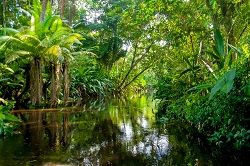GNSS technology for better biomass mapping
Not only is Brazil a large country but much of it is covered by the dense Amazon rainforest. Trying to manage such a rugged and isolated area using traditional mapping, surveying and land management tools is simply impossible. Here, a new land management technology is needed – and that technology is called COREGAL. The COREGAL project aims to harness the combined power of positioning and reflectometry technology in order to create a low-cost, unmanned aerial platform for biomass mapping of the Brazilian Amazon forests. The innovative platform is the first of its kind – combining GNSS technology with drone, or UAV (Unmanned Aerial Vehicle), systems. Traditionally, this sort of work has been completed using a combination of various sensor technology and sources of information. COREGAL, however, disrupts this approach by bringing a new sensor to the market, one capable of providing additional data to further improve upon existing products. Thus, on the one hand, COREGAL’s UAVs are equipped with a Galileo-enabled GNSS receiver that serves as the main sensor for positioning information and biomass estimation. However, as Galileo signals aren’t always able to reach through the thick canopies of Brazil’s jungles, the COREGAL platform combines this traditional receiver with reflected GNSS signals (GNSS-R) that are capable of cutting through the dense canopy environment. Combined together, the platform provides the end user with a high accuracy, lower costs solution for land management and biomass mapping. How does the system work? In the COREGAL system, the GNSS satellite in space serves as the transmitter and the UAV works as the receiver. The transmitted signal from the satellite is reflected off the ground, acquiring information about the surface’s characteristics – including obstacles – along the way. This reflected signal is then received by the UAV’s biomass sensor, which extracts the data about the reflected surface (ie, the ground) from the reflected signals. Specific to its application to biomass mapping, as the signal is reflected back up through the tree canopies, branches and leaves, important biomass data is captured, and subsequently extracted by the UAV receiver. ‘Integrating positioning and reflectometry in a single device within a UAV offers a unique value proposition,’ explains project coordinator Pedro Freire da Silva. ‘Furthermore, GNSS-R signal properties allow for a lower saturation level than traditional radar systems, providing the end user with greater sensitivity to a higher level of biomass density.’ Benefits and next steps Understanding an area’s biomass is essential to being able to assess the economic, conservation and biofuel potential of a given land surface. Furthermore, this biomass data can be used to estimate the amount of carbon stored in a forest – which is important to understanding the potential environmental and climate consequences that any planned land use could have. With this information in hand, local governments can mitigate against deforestation and forest degradation activities that could release harmful carbon gasses. Currently, test campaigns to validate the COREGAL platform are ongoing. Although the recently conducted first test flight was a success, Silva notes that there have been challenges along the way. For example, during several test campaigns, various interference sources were noted, making it more difficult to receive the Galileo signal, which relies on the E5 radio-frequency band. That being said, project coordinator remains upbeat: ‘We expect these tests to demonstrate the commercial viability of the COREGAL concept for biomass measurement,’ says Silva. ‘The key advantage of the platform being the substantial cost reduction and increase in biomass mapping accuracy it provides.’ Silva also notes the project is expected to help accelerate the adoption of Galileo-based technology in Brazil, with potential trickledown benefits for related European projects and business ventures. For more information please see: project website(opens in new window)
Countries
Portugal



